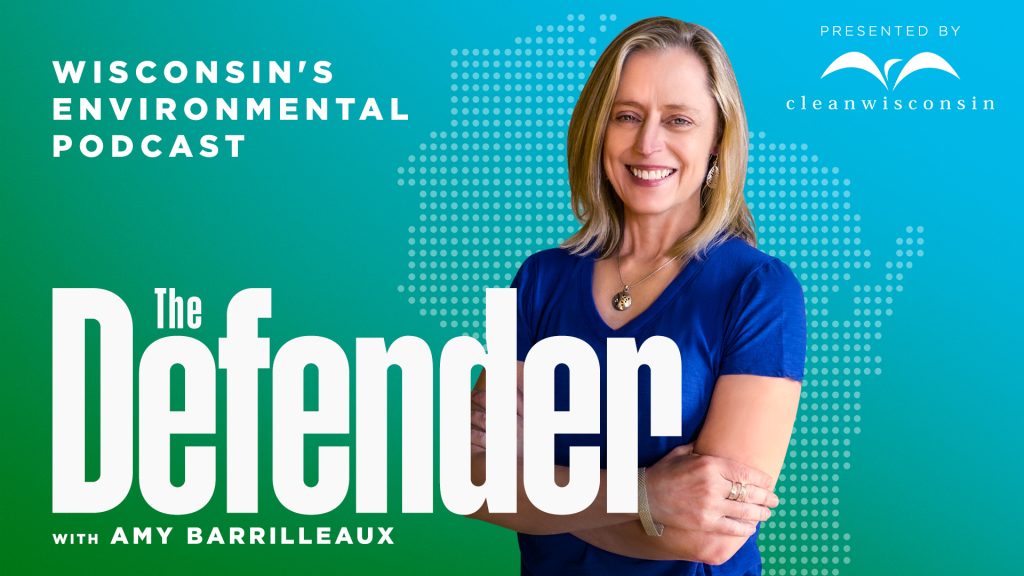Where to Listen:
It’s not easy to locate and document Wisconsin’s endangered species, but luckily Ernie and Betty White are on the case! They are two of Wisconsin’s specially-trained conservation dogs, and they could be the secret to finding some of our state’s most threatened species.
Host:
Amy Barrilleaux
Guests:
Laura Holder, Owner, Conservation Dogs Collective
Betty White, Ernie, and Boxie
Resources for You:
Episode 33: Wisconsin’s bees are acting weird. Here’s why.
Episode 11: Wisconsin’s Vanishing Bee
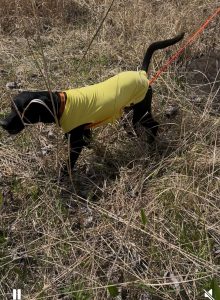
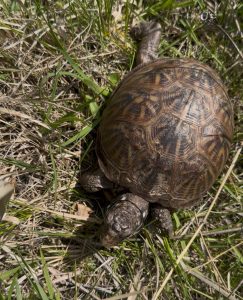
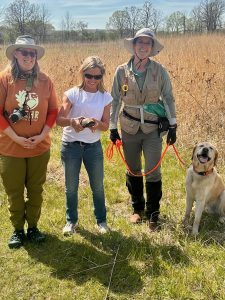
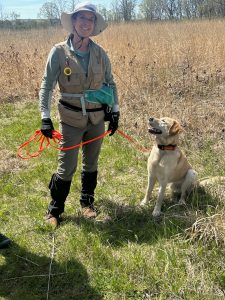
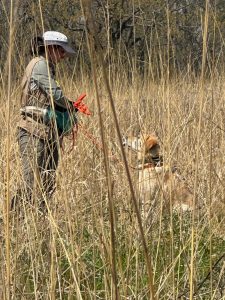
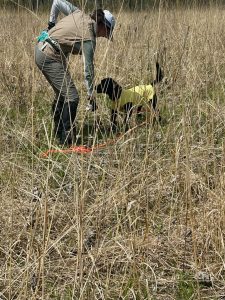
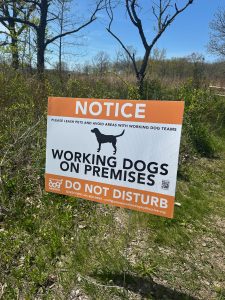
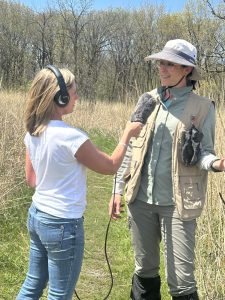
Transcript:
Amy Hi there, and welcome to The Defender, Wisconsin’s environmental podcast. I’m Amy Barilleaux. This is the show where we talk about environmental news and issues impacting Wisconsin. And we also meet people who are working to make a difference to protect the air we breathe, the water we drink, our health, our climate, and our land. The Defender is powered by Clean Wisconsin, your environmental voice since 1970. So what does it take to protect Wisconsin’s endangered and threatened wildlife? Well, it starts with finding out where the threatened species are. Their habitat, what the population numbers are. And that kind of field survey work is time-consuming and hard, especially when those endangered species are small. Like rusty patched bumblebees and ornate box turtles. For listeners who may not know ornate box turtles are about the size of a hamburger. But luckily, Ernie and Betty White are on the case. They are two of Wisconsin’s specially trained conservation dogs. And they could be the secret to finding some of our state’s most threatened species. We’ll meet them and their trainer. That’s right now on The Defender. Ornate box turtles are native to Wisconsin, but they are also endangered here. The biggest threat, habitat loss. The small turtles with bright patterns on their shells are the only Wisconsin turtles that live totally on land. For decades, there’s been ongoing conservation work to rebuild populations here. And now part of that work involves dogs. And a 40 to 50 year old ornate box turtle named Boxie. On a warm, sunny day, I head to Wehr Nature Center in Franklin. To talk with Laura Holder from the Conservation Dogs Collective. Her Labrador Retrievers Ernie and Betty White have helped sniff out all kinds of creatures, including bumblebees and turtles. Today they are on a training mission to see how long it takes them to find Wehr Nature Center’s resident ornate box turtle, named Boxie, tucked away somewhere in the tall grass. But first, I talk with Laura about how the Conservation Dogs Collective got started. So how did you come up with this idea, I guess, to have dogs that help find endangered species, what was the inspiration?
Laura Yeah, so. In 2016, I received a phone call from the executive director of Mequon Nature Preserve. Um, and she had gotten my name through the Milwaukee area community for scent detection. At that time I was teaching canine nose work, which is a more like competitive sport. And she had come back from a conference. And they had a conservation dog demonstration and she was immediately like, this is the coolest thing ever. I want to bring this back to Mequon Nature Preserve because they have about 450 acres of land that’s constantly under restoration. So we had a phone call and I admittedly didn’t know what a conservation dog was. So I was sitting at my computer on the phone and I’m Googling like, what is a conservation dog? And from there, like. Kind of long story short. Um… I founded the Midwest Conservation Dogs, that was our original name, and then. Um… Had gotten my own two dogs since that time in 2017. And here we are today, 2025.
Amy So we’re gonna stop walking for a second just so I can like not get tangled up on brush.
Laura Yeah, we can stand for a second, yeah.
Amy So, um. I mean I guess we all know that dogs can smell things better than people, like how much better though are dogs at finding what they’re looking for?
Laura Well, the sense of smell when you compare dogs versus humans, the research says about 40 times greater sense of smell than us. What makes dogs incredibly useful for conservation detection is their ability to traverse terrain in a much quicker fashion than we can. And then they also obviously rely on their nose a lot more than their their eyeballs and their other senses so they can smell things that are hidden really well. In the environment. So with our turtles that hide under a bunch of grass or bumblebee nests that… established underground, the dogs can smell those Particular species. Um, and they just want their paycheck, their little cheese or toy, you know, for
Amy You didn’t start off. You know, working conservation. You were training dogs for competition. What has the change been like to suddenly be training dogs for something totally different?
Laura Yeah, it’s, there’s a lot of carryover and as far as like training the humans is the biggest part of the job, to be honest. On top of that, with conservation work, a lot of times we’re out in the wilderness, so the sport of canine nose work, we’re not really outside in the middle of a prairie or working in wooded areas. So getting myself used to and my dogs used to working in those conditions versus a two minute long search that might be in a high school gymnasium.
Amy What was the reaction like in the, I guess, conservation community here in Wisconsin when… they found out, hey, you’ve got some specially trained dogs to help them find endangered species?
Laura Like not a lot of people still know about us, but every time I engage with somebody that has heard about a conservation dog locally. They’re like, first off, they usually say, oh my gosh, I didn’t even know you were here. You know, I don’t know dogs could do that. And then they get really engaged in talking about the various projects that we’re working on. And they are kind of. Also, if they’re dog lover, I’m also looking at bumblebees. Um, a lot of times they’ll say, oh, my dog’s also, you know, really nosy. Can my dog do this type of work as well? So there’s kind of different places that the conversation goes depending on who I’m talking to at that point.
Amy Does it feel meaningful to know that you’re out looking for these other kinds of animals that are endangered or are disappearing?
Laura Absolutely. Um, and I will say that working alongside dogs, dogs are an excellent way to get people engaged, including myself. So I grew up not really in a conservation focused family, not that my family is horrible and tearing down habitats, but when I learned about conservation dogs back in 2016 I was like, well how cool is this, right? Like I immediately got engaged in learning about all the invasive species work that they can do, all the endangered or just cryptic species work that they can do to help lend their capable noses, right, and then get more people engaged and talking about whether or not they’re going to do this work with their dog, just their immediate community and what species might be prevalent and how they can help restore or protect what might be going on within a mile radius of their house even.
Amy What’s a typical day like for you then when you come out here to a space like this?
Laura Training Day or Survey Deployment Day, I’m- usually going to be doing an initial kind of top level safety analysis. So I’m looking at, okay, is the weather kind of looking like it was supposed to be forecasted? Do I see any kind of physical hazards? You know, whether that’s down to trees or, you know, I’m looking off in the horizon and I see that there might be a farm field so there could be potentially some barbed wire. So I first do that safety check for myself and my dogs. And then I start to gage, you know, wind direction. If we have a wind, which we do today, which is lovely. And start to kind of segment out how I’m gonna attack a particular search area with the dogs. And that could mean I might kind of quadrant out an area and work it more in a zigzag grid transect or I might do more of a free range kind of meandering survey with the dogs. In addition to that, the project partners that I’m working alongside will pretty much meet me right away as well, so they might also have some strategies or areas that they want me to focus on during my visit. Um, and then I make sure I have all of my goodies in my bag, which has been, you know, packed two nights before, usually, with the first aid kit for myself, for the dogs in case if we get any kind of minor cuts scrapes whatever in the field. And then we head out and I bring one dog out at a time and the other one gets to wait Somewhat patiently For their turn.
Amy Have you, I mean, have you had success doing this? Today we’re going to be looking for an endangered turtle, which we’ll talk about later, but if you have had success, what did that feel like?
Laura We have had success. So today we’re doing ornate box turtles. That’s the first time I’ve ever worked on that particular species with my own dogs So he have a somewhat special purview into seeing what that looks like. But I’ve worked on Blanding’s turtle projects and some of the Bumble Bee work as well. And wood turtles back in 2019. I don’t remember totally the question behind all that.
Amy So when you… have found, or your dogs have found these species, what did it feel? First of all, what did the dogs feel like? I guess they felt just normal, happy.
Laura I do feel like, regardless of what the dogs are finding whether it’s invasive or endangered right they’re like cool I get my ball, my toy whatever. So they don’t necessarily have a sliding scale as far as well I want to find a turtle today not a bumblebee. That said, I get very excited when they find the things that they are trying to find. So just naturally with the relationship I have with my dogs, when I get more excited and animated, they tend to get more excited and animated. Um… So you might see it today during training, you know, they know it’s squeeze cheese time and they start jumping around and doing all sorts of crazy stuff. So it’s really cool and like this is where my just being a dog lover and a dog trainer. First before I came into this. I have a special appreciation for, like, it never… I never take for granted. Yes, I’ve trained my dogs to find turtles, bumblebees, and so on. But when they actually find it in the field, every time is like the very first time, you know? Like it’s not like, oh, you found a 10th bumblebee nest today, big deal. I’m like, no way, man. That’s awesome that you’re finding you know, more nests and things.
Amy Do you think that you and your dogs are you know, making a difference, and it’s maybe not the… You know, earth-shattering difference that… People might think of, but I think in your in your own way, you’re out here trying to… to help with our disappearing different types of species in Wisconsin.
Laura I like to say we’re making a snifferance.
Amy Oh my gosh.
Laura Um Yeah, I do think we’re making a difference. The dogs have collected data. Especially bumblebee nests in particular, because we’ve been working on that for several years in a row now. They’re finding nests in places that human only surveyors just never really would have thought to look, you know, in somewhat I’ll say boring habitats taken over by non-native species. Without a lot of flowering plants. So like to me, I’m like, that’s incredibly valuable. The nice thing about dogs too is they are very unbiased. They aren’t going to be like, well, turtles have always been found here, so I’m only going to search here. Their noses will take them into places where we might not be thinking a turtle’s gonna be. You know, sunbathing or kind of hunkered down on a cold day. So they’re. Again, like… Proving to us as humans, like we don’t know everything, which I think is lovely. Uh… And yeah, I think every time I go out with them too, they’re showing me different ways that odor is going to be moving in an environment as well. And for me to actually share that with future conservation dog handlers or even folks that are maybe making a transition into this work from another field, I think that’s incredibly valuable information for the growth of the industry and the preservation of our natural habitats.
Amy Have you found yourself learning to trust the dogs more or maybe the people who are with you? Oh, we’re going over here, it seems like a weird spot, but maybe this is the spot.
Laura There is a mantra in detection is trust your dog. I like to add trust your training and trust your dog at all times, even if they pull off of a transect in pursuit of something that might not be a target odor. Like a pile of scat or something, right? I still want to honor what they’re telling us, because you never know. Like, even if I think it might be a scat, actually, oh my gosh, it’s a turtle. Hanging out underneath a pine tree, and they’ve never been found under pine trees. So I think it’s cool to have our research partners or our clientele and even people that volunteer with us in the field also get to witness that live, you know, watching the dogs truly follow their noses around. I think it’s just. It’s like, trust the dog, learn something from the dog too, you know, I think that’s something I never get bored Working with my dogs, whether we’re sniffing recreationally or, you know, for.
Amy So tell me about these two dogs. They are… I guess professionally trained sniffers or how would you describe it?
Laura I’ll call them professionally trained working dogs for sure. So we have Ernie, who is my eight-year-old yellow Labrador retriever. I got him when he was a 10-week-old puppy. And I raised him for this type of work from the ground up. Um, doing all sorts of kind of basic sent puppy stuff back in the day. But also teaching them how to be a dog in human world because to me that’s very important. The work is highly seasonal so we do have off season and I live in the middle of a city, so my dogs having appropriate skills for that environment is very important. And then I have Betty White, who’s almost six years old. She’s the chatty one in the background. Um, brought her home at eight weeks as well and raised her to do conservation work with the same type of training from puppyhood on.
Amy Now tell me about that name, Betty White, because… I think she’s a black lab, is that right?
Laura Yes, Betty White is a black Labrador Retriever? When I knew I was gonna get a second labrador for this work. I was engaged with the breeder at that time and she asked if I cared if I got a male or a female I’m like nope as long as the dog is good for the fit that I’m going to be um, providing him or her, I have no preference. And when she, I remember, uh, Kaitlynis her name. When she told me what puppy she had selected for me she’s like, well, you’re gonna get the white collar female. So they had different color collars on the puppies. And my husband and I already were kind of like having a short list of names for little girls and little boys, and Betty was one and when- Kaitlyn said, you’re going to get the white collar. I was like, we can. Name her Betty and then I was like Betty White collar and I was like wait a minute it’s Betty White and Betty White’s obviously an amazing human being so.
Amy Who loved animals.
Laura Who loved animals, yeah. We tried to get her to meet the two Betty Whites together before she passed. We tried on social, but…
Amy But now you’ve got a beautiful black Lab betty White who’s making a difference along with her fellow co-worker.
Laura Right, Ernie and Betty.
Laura They’re the dynamic duo.
Amy Well, we’re going to meet them and I guess follow you out on what are we going to be doing today exactly.
Laura Yeah, so we are actually going out for field surveys next week Monday. And hopefully Tuesday, depending on the weather. So today’s our last day of field training. We are partnered with Wehr Nature Center and Brooke, one of their staff members is hiding their ambassador turtle. Their ornate box turtle named boxy, who is somewhere between 40 and 50 years of age. Which is you know, pretty remarkable. So, she… Brooke has hidden Boxie somewhere out in this prairie area. And I’m going to be running blind, so what that means is I don’t know where it is. Although Brooke is going to have an eye on Boxie at all times. She holds all the permitting with Wehr Nature Center to be handling the endangered species. And Boxie’s pretty, uh, she’s pretty low energy, so she’s not gonna be really moving around too much, but still, Brooke’s gonna be keeping a dedicated eye on her. I’m going to bring out one dog at a time. And we’re gonna have them sniff out where Boxie is located. And then they get their cheese when they find her.
Amy And they won’t hurt Boxie.
Laura Nope, they are trained to do a passive, they call it a passive response, pass or final. Passive final response. So, they’d get as close as they can to her, but they are trained not to otherwise physically engage with her. So not picking her up in their mouths, not moving her around with their feet or anything.
Amy So how will you know when they have found Boxie?
Laura When they find Boxie, they should stand still and then look back at me. And be like, yo, it’s right here. They’re basically saying, hurry up come over. Boxie is right in front of my feet, basically. I want my cheese.
Amy Give me my cheese!
Laura Yes, exactly. They are Wisconsin dogs. They love their cheese. and before they actually find her I usually am looking for changes in direction all of a sudden. Where that is usually an indicator of like, hey, I just smelled the smell of a turtle. I wanna go find where she is. Um, and Labradors and other, lots of breeds, but hunting breeds in particular, um, we’ll do quartering. So they kind of go back and forth. It’s a zigzagging where the scent cone is located. Yeah, it should be fun. We have a nice wind out here. I’m very excited about this.
Amy All right, well, we’re going to find Boxie and um… Have some cheese. Have some Cheese. Yeah, exactly. Alright! The energetic and talkative Betty White got to work first. It took Betty just a few circles and zigzags to find Boxie nestled underneath some tall grass. A few minutes later, quiet, very chill, Ernie had his chance, he sniffed out Boxie almost immediately and calmly. Waited for his cheese.
Laura Yes! Good boy!
Amy Did he find her already? Yeah, he’s gone already.
Amy Huge thank you to Laura, Wehr Nature Center, and of course, Betty White and Ernie and Boxie. For photos and videos from the day and more information on the dogs and Wisconsin’s endangered species check out the show notes or head to our website, cleanwisconsin.org. And thank you for listening. I’m Amy Barrilleaux, talk to you next week.
